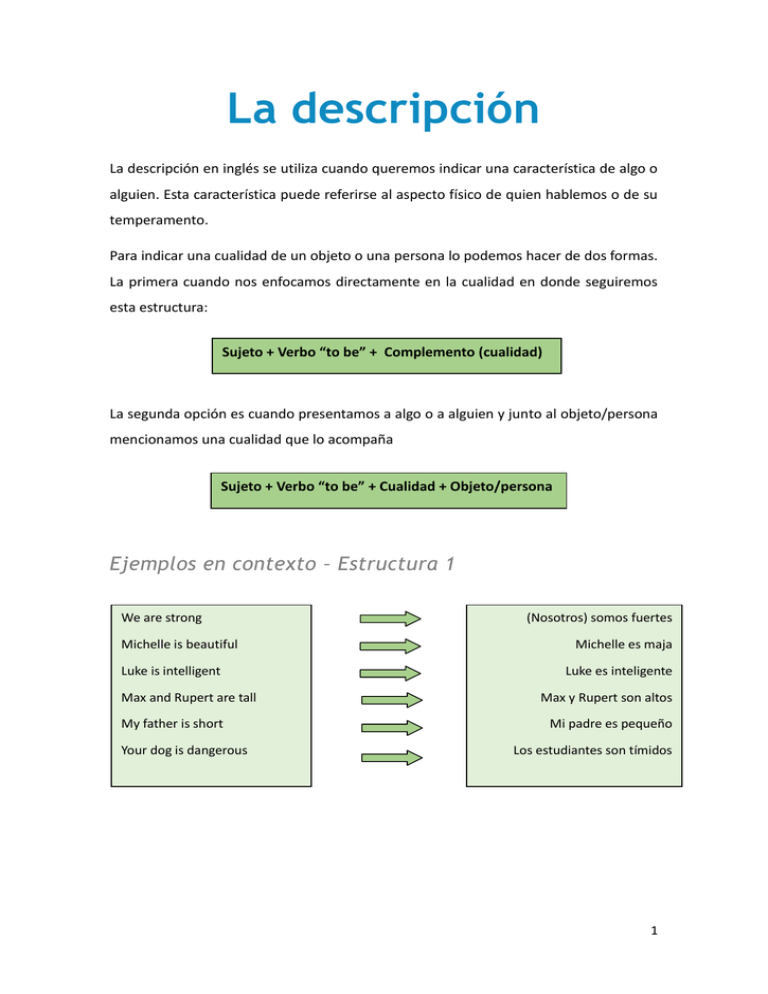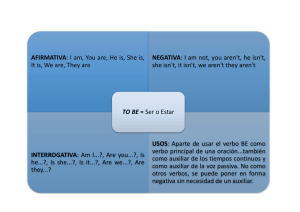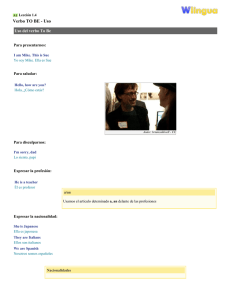La descripción - cloudfront.net
Anuncio

La descripción La descripción en inglés se utiliza cuando queremos indicar una característica de algo o alguien. Esta característica puede referirse al aspecto físico de quien hablemos o de su temperamento. Para indicar una cualidad de un objeto o una persona lo podemos hacer de dos formas. La primera cuando nos enfocamos directamente en la cualidad en donde seguiremos esta estructura: Sujeto + Verbo “to be” + Complemento (cualidad) La segunda opción es cuando presentamos a algo o a alguien y junto al objeto/persona mencionamos una cualidad que lo acompaña Sujeto + Verbo “to be” + Cualidad + Objeto/persona Ejemplos en contexto – Estructura 1 We are strong Michelle is beautiful Luke is intelligent Max and Rupert are tall My father is short Your dog is dangerous (Nosotros) somos fuertes Michelle es maja Luke es inteligente Max y Rupert son altos Mi padre es pequeño Los estudiantes son tímidos 1 Ejemplos en contexto – Estructura 2 We are strong people (Nosotros) somos gente fuerte Michelle is a beautiful woman Michelle es una mujer maja Luke is an intelligent boy Luke es un niño inteligente Max and Rupert are tall men Max y Rupert son hombres altos My father is a short man Mi padre es un hombre pequeño Your dog is a dangerous animal I. Tu perro es un animal peligroso Orden de los adjetivos A diferencia del español, cuando presentamos algo o alguien en inglés utilizando la estructura 2; la cualidad no la mencionaremos después del objeto sino antes. These are my favorite cities Ésta es mi ciudad favorita She is the perfect woman Ella es la mujer perfecta That is a dirty envelope Ese/aquel es un sobre sucio My husband is a handsome man Mi esposo es un hombre apuesto En caso de usar dos adjetivos para describir, mencionaremos un adjetivo seguido del otro sin necesidad de utilizar un conector. A diferencia del español donde utilizamos el conector “y”. They are attractive blond women Ellas son mujeres atractivas y rubias This is a cosmopolitan big city Ésta es una ciudad cosmopolita y grade This is a touching beautiful letter Ésta es una carta conmovedora y hermosa My husband is a professional handsome Mi esposo es un hombre profesional y man apuesto 2 II. Forma negativa En vista que para hacer una descripción utilizamos en la mayoría de los casos el verbo “to be”, para realizar la negación agregaremos la partícula “not” después de este verbo o utilizamos sus respectivas contracciones en la forma negativa: “isn’t” o “aren’t”. Sujeto + Verbo “to be” + not + Complemento (cualidad) Sujeto + Verbo “to be” + not + Cualidad + Objeto/persona This isn’t a big cosmopolitan city Esta no es una ciudad grande ni cosmopolita These aren’t my favorite books Éstos no son mis libros favoritos They aren’t tall woman Ellas no son mujeres altas She is not a jealous short woman Ella no es una mujer celosa ni pequeña That isn’t a dirty red envelope Este no es un sobre sucio ni rojo This isn’t a touching beautiful letter Ésta no es una carta conmovedora ni My husband isn’t a handsome man Mi esposo no es un hombre apuesto He is not a suspicious blond man III. Él no es un hombre sospechoso ni rubio Forma interrogativa Para preguntar por una cualidad de algo o de alguien, hay dos tipos de preguntas que pueden referirse por un lado a una característica física y por otro al temperamento/personalidad o estado de ánimo. Para referirnos a una cualidad física se utiliza la siguiente estructura: What + Verbo “to be” + Sujeto + Like + ? 3 What is your mother like?/ ¿Cómo es tu madre (físicamente)?-¿Cómo luce tu madre? My mother is beautiful Mi madre es maja She is a blond woman Es una mujer rubia What are they like?/ ¿Cómo son ellos (físicamente)?-¿Cómo lucen ellos? They are young Ellos son jóvenes They are old men Son hombres viejos Para referirnos a la personalidad, temperamento o estado de ánimos de alguien, se utiliza la siguiente estructura: How + Verbo “to be” + Sujeto + ? How is your mother? ¿Cómo es tu madre(personalidad, temperamento)? My mother is friendly Mi madre es amigable She is a generous woman Es una mujer generosa How are they? ¿Cómo son ellos (personalidad, temperamento)? They are sad Están tristes They are serious men Son hombres serios Otra opción de la forma interrogativa es cuando queremos confirmar si una cualidad le pertenece o no a la persona o objeto del que hablamos. En este caso hacemos uso de las “yes/no questions” siguiendo esta estructura: Verbo “to be” + Sujeto + cualidad + ? Is Michael fat? Es Michael gordo? Yes, he is fat Sí, es gordo No, he isn’t fat No, no es gordo Are they friendly? Son ellos amigables? Yes, they are friendly Sí, son amigables No, they aren’t friendly No, no son amigables 4 TEST ¿Cuál de las siguientes frases no corresponde a una descripción que utilice la estructura 1? a) I am old b) They are tall men c) She is beautiful d) My borthers are intelligent 1. ¿Cuál de las siguientes frases no corresponde a una descripción que utilice la estructura 2? a) I am a friendly man b) Teresa is a nice girl c) They are young teachers d) Those teachers are old 2. ¿Cuál de las siguientes frases es incorrecta? a) You are a responsible and serious student b) My mother is a outgoing nice woman c) Her best friends are friendly d) Her sister is excited 3. ¿Cuál de las siguientes frases no corresponde a una descripción física? a) It is a dangerous elephant b) They are nice friends c) Lucy is a talented woman d) Bob and Luke are athletic men 4. ¿Cuál de las siguientes frases no corresponde a una descripción de la personalidad/carácter? a) Susan is smart b) Greag is a blond man 5 c) Julian and his brother are outgoing bothers d) Damian is a nice teacher 5. ¿Cuál pregunta corresponde a la respuesta “He is very happy” a) What is he like? b) He is very happy? c) How is George? d) How is she? 6. ¿Cuál pregunta corresponde a la respuesta “The teacher is very handsome” a) How is the teacher? b) What is he like? c) He is very handsome? d) Is the teacher uggly? 7. ¿Cuál es la respuesta correcta a la pregunta “are the students responsable?” a) Yes, they are very happy b) Yes, the students are not c) No, they aren’t responsable d) No, they are no 8. ¿Cuál es la respuesta correcta a la pregunta “are yout cousins generous?” a) No, my cousins generous not b) Yes, they are not generous c) No, they’re generous d) Yes, they are generous 9. ¿Qué pregunta es incorrecta? a) How are you like? b) What are you like? c) How are you? d) What is she like? 6

